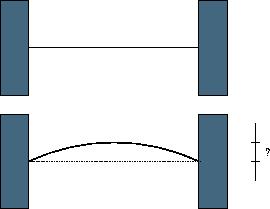Expanding Rods
| Time Limit: 1000MS | Memory Limit: 30000K | |
| Total Submissions: 10901 | Accepted: 2802 |
Description
 When a thin rod of length L is heated n degrees, it expands to a new length L'=(1+n*C)*L, where C is the coefficient of heat expansion.
When a thin rod of length L is heated n degrees, it expands to a new length L'=(1+n*C)*L, where C is the coefficient of heat expansion. When a thin rod is mounted on two solid walls and then heated, it expands and takes the shape of a circular segment, the original rod being the chord of the segment.
Your task is to compute the distance by which the center of the rod is displaced.
Input
The input contains multiple lines. Each line of input contains three non-negative numbers: the initial lenth of the rod in millimeters, the temperature change in degrees and the coefficient of heat expansion of the material. Input data guarantee that no rod expands by more than one half of its original length. The last line of input contains three negative numbers and it should not be processed.
Output
For each line of input, output one line with the displacement of the center of the rod in millimeters with 3 digits of precision.
Sample Input
1000 100 0.0001 15000 10 0.00006 10 0 0.001 -1 -1 -1
Sample Output
61.329 225.020 0.000
思路:采用对半径进行二分的思想

1 #include<iostream> 2 #include<stdio.h> 3 #include<string.h> 4 #include<math.h> 5 #define M 0xfffffff 6 using namespace std; 7 int main() 8 { 9 double n,L,L1,c; 10 while(scanf("%lf%lf%lf",&L,&n,&c)!=EOF) 11 { 12 if(L<0) 13 break; 14 if(n*c<0.000001)//此种情况不能构成圆形 15 { 16 printf("0.000 "); 17 continue; 18 } 19 L1=(1+n*c)*L; 20 double low=0,high=M,mid; 21 while(high-low>0.000001) 22 { 23 mid=(high+low)/2; 24 double angle=asin(0.5*L/mid); 25 if(2*angle*mid<L1) 26 high=mid; 27 else 28 low=mid; 29 } 30 printf("%.3lf ",mid-sqrt(mid*mid-0.5*L*0.5*L)); 31 } 32 return 0; 33 }
